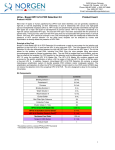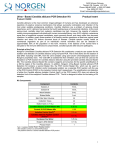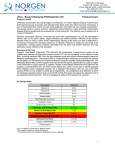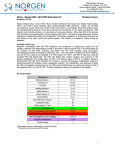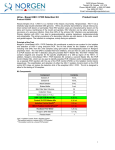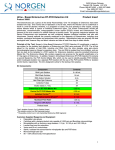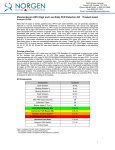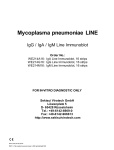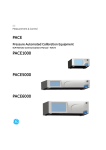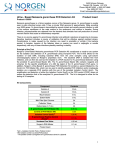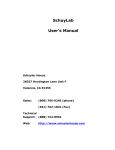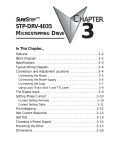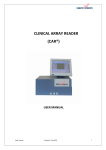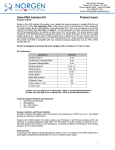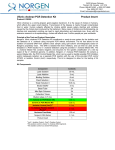Download Urine-Based HPV (High and Low Risk) PCR Detection Kit
Transcript
3430 Schmon Parkway Thorold, ON, Canada L2V 4Y6 Phone: 866-667-4362 • (905) 227-8848 Fax: (905) 227-1061 Email: [email protected] Urine - Based HPV (High and Low Risk) PCR Detection Kit Product Insert Product # 31500 More than 70 types of human papillomavirus (HPV) have been identified, and are generally classified as high-risk or low-risk depending on their relationship or lack of relationship with cancer and high-grade cervical intraepithelial neoplasia (CIN 2-3). HPV viruses are predominantly sexually transmitted and high-risk HPV types are a major risk factor for development of cervical cancer. Low-risk HPV types 6 and 11 have been associated with the presence of genital warts. There are many other low-risk HPV types that are not associated with genital warts or cervical cancer. Until now, HPV cannot be cultured in vitro, and immunological tests are inadequate to determine the presence of HPV cervical infection. On the other hand, biopsies can be analyzed by nucleic acid hybridization to directly detect the presence of HPV DNA. HPV 16 and HPV 18 have been considered as high-risk cancer associated HPV types. HPV types 31, 33, and 35 have been shown to have an intermediate relationship with cancer. These five HPV types together account for about 80% of cervical cancers. Additional high- and intermediate-risk HPV DNA types, including types 39, 45, 51, 52, 56, 58, 59 and 68, have been identified as the principal HPVs detectable in the remaining cancers. Principle of the Test Norgen’s Urine-Based HPV (High and Low Risk) PCR Detection Kit constituents a ready-to-use system for the isolation and detection of 18 HPV DNA groups low-risk HPV types 6/11/42/43/44; and high/intermediaterisk HPV types 16/18/31/33/35/39/45/51/52/56/58/59/68 using end-point PCR. Norgen’s Urine-Based HPV (High and Low Risk) PCR Detection Kit cannot determine the specific HPV type. The kit first allows for the isolation of total DNA, including viral DNA, from the urine samples using spin-column chromatography based on Norgen’s proprietary resin. The viral DNA is isolated free from inhibitors, and can then be used as the template in a PCR reaction for HPV (High Risk) and HPV (Low Risk) detection using the provided HPV HLR Master Mix. The HPV Master Mix contains reagents and enzymes for the specific amplification of a 280 bp region of HPV High and Low Risk. In addition, Norgen’s Urine-Based HPV (High and Low Risk) PCR Detection Kit contains a second heterologous amplification system to identify possible PCR inhibition and/or inadequate isolation. The amplification and detection of either the HPV Isolation Control (IsoC) or the PCR control (PCRC) does not reduce the detection limit of the analytical HPV (High and Low Risk) PCR. The kit is designed to allow for the testing of 24 samples. Kit Components: Component Contents Binding Solution I 20 mL Proteinase K 0.6 mL Pronase 0.6 mL Binding Solution II 3 mL Wash Solution I 4 mL Wash Solution II 12 mL Elution Buffer 3 mL Mini Filter Spin Columns 24 Collection Tubes 24 Elution tubes (1.7 mL) 24 HPV 2x PCR Master Mix 0.35 mL a HPV Isolation Control (IsoC) b 0.4 mL HPV Positive Control (PosC) 0.1 mL HPV Negative Control (NegC) 1.25 mL Norgen’s DNA Marker 0.1 mL Product Insert 1 `a The positive control is a cloned HPV product b The isolation control is a cloned PCR product 1 Customer-Supplied Reagents and Equipment • Disposable powder-free gloves • Centrifuge with a swinging bucket rotor capable of 2000 x g • Benchtop microcentrifuge • Micropipettors • Sterile pipette tips with filters • PCR tubes • 96 – 100% ethanol • 60°C incubator • 15 mL tubes Storage Conditions and Product Stability All buffers should be kept tightly sealed and stored at room temperature (15-25oC) for up to 1 year without showing any reduction in performance. Norgen’s Urine-Based HPV (High and Low Risk) PCR Detection Kit contains ready-to-use Proteinase K and Pronase solutions, which are dissolved in a specially prepared storage buffer. The Proteinase K and the Pronase are stable for up to 1 year after delivery when stored at room temperature. To prolong the lifetime of Proteinase K and Pronase, storage at 2–8°C is recommended. The HPV 2x PCR Master Mix, the HPV Isolation Control (IsoC), the HPV Positive Control (PosC) and the HPV Negative Control (NegC) should be kept tightly sealed and stored at -20oC for up to 1 year without showing any reduction in performance. Repeated thawing and freezing (> 2 x) should be avoided, as this may reduce the sensitivity. If the reagents are to be used only intermittently, they should be frozen in aliquots. General Precautions The user should exercise the following precautions while using the kit: • Use sterile pipette tips with filters. • Store and extract positive material (specimens, controls and amplicons) separately from all other reagents and add it to the reaction mix in a spatially separated facility. • Thaw all components thoroughly at room temperature before starting an assay. • When thawed, mix the components and centrifuge briefly. • Work quickly on ice. Quality Control In accordance with Norgen’s ISO 9001 and ISO 13485-certified Quality Management System, each lot of Norgen’s Urine-Based HPV High and Low Risk PCR Detection Kit, the HPV 2x PCR Master Mix, the HPV Isolation Control (IsoC), the HPV Negative Control (NegC) and the HPV Positive Control (PosC) are tested against predetermined specifications to ensure consistent product quality. Product Use Limitations Norgen’s Urine-based HPV High and Low Risk PCR Detection Kit is designed for research purposes only. It is not intended for human or diagnostic use. Product Warranty and Satisfaction Guarantee NORGEN BIOTEK CORPORATION guarantees the performance of all products in the manner described in our product manual. The customer must determine the suitability of the product for its particular use. Safety Information Ensure that a suitable lab coat, disposable gloves and protective goggles are worn when working with chemicals. For more information, please consult the appropriate Material Safety Data Sheets (MSDSs). These are available as convenient PDF files online at www.norgenbiotek.com. 2 CAUTION: DO NOT add bleach or acidic solutions directly to the sample-preparation waste. The Binding Solution I, Binding Solution II, Wash Solution I and Wash Solution II contain guanidine hydrochloride, and should be handled with care. Guanidine hydrochloride forms highly reactive compounds when combined with bleach, thus care must be taken to properly dispose of any of these solutions. If liquid containing these buffers is spilled, clean with suitable laboratory detergent and water. If the spilled liquid contains potentially infectious agents, clean the affected area first with laboratory detergent and water, and then with 1% (v/v) sodium hypochlorite. 1. Protocol A. Specimen Collection, Storage and Transport Precaution: All samples have to be treated as potentially infectious material. 1. Specimen Collection and Sample Storage • Midstream urine samples should be collected, as the first flow of urine has been shown to have a higher rate of contamination (Morimoto et al., 2003). • It is highly recommended that urine samples be collected using Norgen’s Urine Collection and Preservation Tubes (Cat# 18111). The urine samples can be stored for at least one year at room temperature when collected directly using Norgen’s Urine Collection and Preservation Tubes. • Alternatively, urine samples collected using any other collection and preservation systems or reagents are also compatible with this kit. 2. Sample Transport • Sample material should be transported in a shatterproof, leak-proof transport container as a matter of principle. Thus, a potential danger of infection due to a leakage of sample can be avoided. • The samples should be transported following the local and national instructions for the transport of pathogen material. B. Isolation of DNA from Urine Notes: • Do not spin down or filter the urine sample before proceeding with the isolation, as this could negatively affect the isolation of HPV DNA. • Ensure that all solutions are at room temperature prior to use, and that no precipitates have formed. If necessary, warm the solutions and mix well until the solutions become clear again. • Always vortex both the Proteinase K and the Pronase before use. • Preheat an incubator or heating block to 60°C. • Prepare a working concentration of Binding Solution II and Wash Solution I by adding the proper volume of 96-100% ethanol (provided by the user) indicated in Table 1 below to the supplied bottle containing the concentrated Binding Solution II and Wash Solution I. The label on the bottle has a box that may be checked to indicate that the ethanol has been added. • Elevated levels of bilirubin (≥15 mg/dl) and lipids (≥800 mg/dl) and haemolytic samples do not influence the system 3 Table 1. Volume of Ethanol to be added to Binding Buffer II and Wash Buffer I Volume Provided Ethanol (96-100%) Volume to Add Final Volume Binding Solution II 3 mL 7 mL 10 mL Wash Solution I 4 mL 11 mL 15 mL • An HPV Isolation Control (IsoC) is supplied. This allows the user to control the DNA isolation procedure. For this assay, add the HPV Isolation Control (IsoC) to the lysate during the isolation procedure. o The HPV Isolation Control (IsoC) must not be added to the sample material directly o Do not freeze and thaw the HPV Isolation Control (IsoC) more than 2 times. o The HPV Isolation Control (IsoC) must be kept on ice at all times during the isolation procedure. 1. Obtain a 5 mL midstream urine sample. Add 700 µL of Binding Solution I to the urine sample and mix well by inversion. (Note: Binding Solution I contains resin and must be mixed well before every pipeting). 2. Centrifuge for 5 minutes at 2,000 x g. Discard the supernatant. 3. Add 20 µL of both Proteinase K and Pronase to the precipitated slurry pellet resulting from 5 mL of the urine sample. Vortex for 10 seconds. 4. Incubate the mixture at 60°°C for 20 minutes. 5. After the 20 minute incubation, add 260µL Binding Solution II, 6. Add 15 µL HPV Isolation Control (IsoC) to the lysate, mix well by pipeting and then transfer the entire contents into a Mini Filter Spin column (provided). 7. Centrifuge for 2 minutes at 6,700 x g, and discard the flow-through. 8. Apply 450 µL of Wash Solution I to the column and centrifuge for 1 minute. Discard the flowthrough and reassemble the spin column with its collection tube. 9. Apply 450 µL of Wash Solution II to the column and centrifuge for 1 minute. Discard the flowthrough and reassemble the spin column with its collection tube. 10. Spin the column for 1 minute in order to thoroughly dry the resin. Discard the collection tube. 11. Transfer the spin column to a fresh 1.7 mL Elution tube. Apply 100 µL of Elution Buffer to the column and centrifuge for 2 minutes at 200 x g (~2,000 RPM), followed by 1 minute at 14,000 x g (~14,000 RPM). C. HPV PCR Assay Preparation Notes: • It is recommended that 10 µL of the DNA elution be used as the PCR sample input volume • Sample volume can be varied between 2 µL – 10 µL of the DNA elution. PCR grade water should be added to make up the final volume of the PCR reaction to 20 µL. 4 • • • • 1. 2. 3. 4. Using a lower volume from the sample than recommended may affect the sensitivity of the HPV Limit of Detection. HPV Negative Control (NegC) and HPV Positive Control (PosC) must be included during every run. The HPV Negative Control (NegC) and HPV Positive Control (PosC) provided are sufficient for eight PCR runs. Before each use, all reagents need to be thawed completely, mixed (by repeated up and down pipetting or quick vortexing), and centrifuged briefly. Prepare PCR reactions as outlined in Table 2 below. For each sample to be run, pipette 10 µL of the eluted DNA and 10 µL of the Master Mix into a PCR tube. Each PCR reaction will have a final volume of 20 µL. HPV Negative Control (NegC) and HPV Positive Control (PosC) must be included in every run. Pipette 10 µL of HPV Negative Control (NegC) into a PCR tube and add 10 µL of Master Mix. Pipette 10 µL of HPV Positive Control (PosC) into a PCR tube and add 10 µL of Master Mix. Program the PCR machine according to the program shown in Table 3 below. Run PCR. Table 2. PCR Assay Preparation Preparation of PCR assay Volume Per PCR Reaction HPV 2X PCR Master Mix 10 µL Sample (Eluted DNA) 10 µL HPV Positive Control (PosC) 10 µL 10 µL ---------- 10 µL ---------- HPV Negative Control (NegC) ---------- ---------- 10 µL Total Volume 20 µL 20 µL 20 µL Table 3. HPV PCR Assay Program PCR Cycle Cycle 1 Cycle 2 (40x) Cycle 3 Cycle 4 Step Temperature Duration Step 1 o 95 C 3 min Step 1 o 94 C 15 sec Step 2 o 60 C 30 sec Step 3 o 72 C 45 sec Step 1 o 72 C 5 min Step 1 o 4C ∞ D. HPV PCR Assay Interpretation • • • For the analysis of the PCR data, the entire 20 µL PCR reaction should be loaded on a 1X TAE, 2% Agarose DNA gel along with 10 µL of Norgen’s DNA Marker (provided). The PCR products should be resolved on the 1X TAE, 2% Agarose gel at 150V for 30 minutes Figure 1 and Table 4 explain how to interpret the PCR assay results 5 M A B C D E F G H NegC M 2000 1500 1000 750 500 Isolation Control (IsoC) 300 HPV target PCR Control (PCRC) 150 50 Figure 1: A representative 1X TAE, 1.7% agarose gel showing the amplification of HPV at different concentrations (Target). The size of the HPV target amplicon corresponds to the 280bp band represented by the provided DNA Marker (M). The size of the HPV Isolation Control (IsoC) corresponds to the 500bp band represented by the provided DNA Marker (M). The HPV 2X PCR Master Mix contains a HPV PCR Control (PCRC). The HPV PCRC Controls for PCR inhibition. The size of the HPV PCRC corresponds to the 150bp band represented by the provided DNA Marker (M). Lanes A-H represents samples spiked with different HPV concentrations isolated from 5mL urine samples (interpreted as positive results). The HPV spiked in urine samples is a cloned PCR product. Table 4. Interpretation of PCR Assay Results Input Type HPV IsoC Band (500 bp) HPV Target Band (280 bp) HPV PCRC Band (150 bp) Interpretation Positive Control X X X Valid X Valid X Positive X Negative X Positive Negative Control Sample X Sample X Sample Sample Sample X X X X Positive X Positive ** For results obtained that are not covered in Table 4 above, please refer to the Troubleshooting Section. E. Specificity The specificity of Norgen’s Urine-Based HPV High and Low Risk PCR Detection Kit is first and foremost ensured by the selection of the HPV-specific primers, as well as the selection of stringent reaction conditions. The primers were checked for possible homologies in GenBank published sequences by sequence comparison analyses. Furthermore, the specificity of the HPV-specific primers were tested against most of the known sexually-transmitted pathogens. 6 F. Linear Range • • • • The linear range (analytical measurement) of Norgen’s Urine-Based HPV (High and Low Risk) PCR Detection Kit was determined by analyzing a dilution series of HPV quantitative standard ranging from 8.46 x 109 VP/µl to 1 x 10-1 IU/µl. Each dilution has been tested in replicates (n = 4) using Norgen’s Urine-Based HPV (High and Low Risk) PCR Detection Kit on 1X TAE, 1.7% Agarose gels. The linear range of Norgen’s Urine-Based HPV (High and Low Risk) PCR Detection Kit has been determined to cover concentrations from 0.2 VP/µl to at least 8 x 106 VP/µl Under the conditions of Norgen’s Urine DNA Isolation procedure, Norgen’s Urine-Based HPV (High and Low Risk) PCR detection Kit covers a linear range from 200VP/mL urine to at least 8 x 109 VP/mL urine. G. Frequently Asked Questions 1. How many samples should be included per PCR run? • Norgen’s Urine-Based HPV (High and Low Risk) PCR Detection Kit is designed to test 24 samples. For every 6 samples, a Negative Control and a Positive Control must be included. It is preferable to pool and test 6 samples at a time. If not, the provided Negative Control and Positive Control are enough to run 3 samples at a time. 2. How can I interpret my results for a sample if neither the HPV PCR control nor the HPV Isolation Control (IsoC) amplifies? • If neither the HPV PCR control nor the HPV Isolation Control (IsoC) amplifies, the sample must be retested. If the positive control showed amplification, then the problem occurred during the isolation, where as if the Positive control did not amplify the problem has occurred during the setup of the PCR assay reaction. 3. How should it be interpreted if only the HPV PCR control showed amplification but neither the HPV target nor the HPV Isolation Control (IsoC) amplified for a sample? • This indicates a poor isolation. The isolation procedure must be repeated. 4. How should it be interpreted if only the HPV Isolation Control (IsoC) was amplified in a sample? • The sample tested can be considered as HPV negative. 5. How should it be interpreted if only the HPV target and the HPV PCR control were amplified in a sample? • The sample tested can be considered as HPV positive. 6. How should it be interpreted if only the HPV target was amplified in a sample? • The sample tested can be considered positive. At high HPV viral load, the HPV amplicon will be predominant and the HPV PCR control as well as the HPV Isolation control may not amplify. 7. How should it be interpreted if only the HPV PCR control and the HPV Isolation Control (IsoC) showed amplification? • The sample tested can be considered negative 8. Can I process a different urine volume? • The reagents provided with the isolation kit are only sufficient to process 24 urine samples of 5mL each. 9. What If I added more or less of the specified reagents’ volume during DNA isolation? • Adding less volume may reduce your DNA yields. Adding more may not affect the DNA yields EXCEPT if more Elution Buffer was added. Eluting DNA in higher volumes of Elution Buffer will result in diluting your DNA. 10. What If my incubation temperature varied from the specified 60°°C? • The incubation temperature can be in the range of 55°C - 65°C. At other temperatures the activity of both the Proteinase K and the Pronase will be reduced. This will result in a reduction in your DNA yields. 7 11. What If my incubation varied from the 20 minutes specified in the product manual? • Less than 20 minutes will result in lower DNA yields. More than 20 minutes may not affect your DNA yields. 12. What If I forgot to do a dry spin after my second wash? • Your DNA elution will be contaminated with the Wash Solution. This may dilute the DNA yield in your elution and it may interfere with your down stream applications. 13. What If I forgot to add the HPV Isolation control during the Isolation? • The Isolation must be repeated. Related Products Urine DNA Isolation Kit Product # 18100 Urine (Exfoliated Cell) DNA Purification Kit 22300 Urine (Exfoliated Cell) RNA Purification Kit 22500 Urine Bacteria DNA Purification Kit 22400 Urine Bacteria RNA Purification Kit 23400 Technical Assistance NORGEN’s Technical Service Department is staffed by experienced scientists with extensive practical and theoretical expertise in sample and assay technologies and the use of NORGEN products. If you have any questions or experience any difficulties regarding Norgen’s Urine-based HPV PCR Detection Kit or NORGEN products in general, please do not hesitate to contact us. NORGEN customers are a valuable source of information regarding advanced or specialized uses of our products. This information is helpful to other scientists as well as to the researchers at NORGEN. We therefore encourage you to contact us if you have any suggestions about product performance or new applications and techniques. For technical assistance and more information, please contact our Technical Support Team between the hours of 8:30 and 5:30 (Eastern Standard Time) at (905) 227-8848 or Toll Free at 1-866-667-4362 or call one of the NORGEN local distributors (www.norgenbiotek.com) or through email at [email protected]. References Morimoto, M., Yanai, H., Chiba, H., Matsuno, K. and Shukuya, K. (2003). Importance of midstream cleancatch technique for urinalysis, reconfirmed by urinary flow cytometry. Clin Chim Acta. 333, 101-102. 3430 Schmon Parkway, Thorold, ON Canada L2V 4Y6 Phone: (905) 227-8848 Fax: (905) 227-1061 Toll Free in North America: 1-866-667-4362 ©2010 Norgen Biotek Corp. PI31500-5 8








